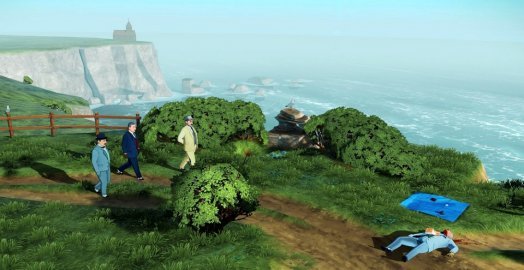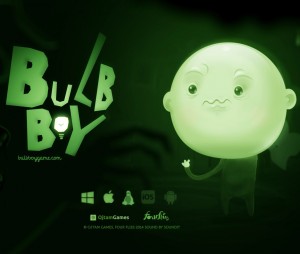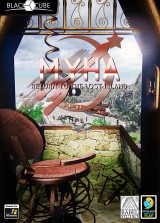Review for The A.B.C. Murders

The last effort to translate Agatha Christie’s The A.B.C. Murders to a video game format – the 2009 Nintendo DS exclusive – was hardly what one would call a runaway success. It was surprising that an interactive adaptation of the Hercule Poirot classic could fail so badly since the murder mystery format lends itself so well to the adventure genre. So for 2016, Microïds and Artefacts Studio have teamed up to take an entirely new stab at the investigation, and to a certain extent have succeeded. It doesn’t sound nearly as good as it looks, but by taking hints from recent Sherlock Holmes titles, the new game is a pleasing adventure that blends puzzles with investigation and storytelling in a fluid, if a tad easy, manner.
The A.B.C. Murders is one of Poirot’s most famous cases, often aped in any number of serial killer movies. Rather than the single-murder-in-a-country-house which was Christie’s usual template, this story features several murders across Britain all undertaken by a sinister criminal who taunts the detective with mysterious letters signed only by the letters A.B.C. The game’s story kicks off after the first of these letters arrives at Poirot’s residence, hinting at a murder in Andover.
What’s immediately striking is the appealing cel-shaded graphics; the character models are fully animated and exist in a 3D setting, but have been given a 2D look. The fixed camera gives a nice parallax effect on scenes where there’s a small rotation of the point of view, in particular a clifftop setting where the close-up bushes move in relation to the distant sea shore. The Art Deco colour palette adds a lovely vibrancy and most locations are alive with action, from circling seabirds and other small critters, to traffic on the roads and passers-by. Care has gone into the character animations, as they move fluidly with no floating, and Poirot interacts with his environment naturally. It all adds up to a slick visual presentation that isn’t often seen in the more casual-friendly end of the adventure genre.
The locations are variations on the quaint British theme, so we’re treated to a quaint British cobblestoned town centre, a quaint British seaside, a quaint British country house and plenty of quaint British shops, houses and hotels. It’s fully in keeping with what one would expect from a Poirot game, but all rendered with a gorgeous ‘living, breathing’ painting aesthetic.
Getting used to the controls doesn’t require any sleuth work. This is a third-person adventure game so you move by clicking the left mouse button to walk and interact with hotspots that appear around the environment. Characters you can speak with either change the cursor to a dialogue box or a pair of spectacles if there are observations available. You play as Poirot throughout the game, with the investigation taking several different forms: you make keen observations of suspects you meet, pick through crime scenes, piece together deductions and reconstruct events. These happen at different points along the way as distinct tasks. For example, at the beginning all you have to go on is the letter you’ve received, meaning you’d better investigate the crime scene. Events take place in a linear fashion, so you can’t overtake yourself or create strange gaps in logic.
The first type of activity you come across upon arriving in Andover is headlined as an ‘observation’. You walk to Inspector Japp and after a brief introduction the cursor changes to a circle and the number of observations you can make appears on the left-hand side. Sweeping the cursor over Japp highlights several things that stand out to Poirot. As you get close to something important, the circle turns a darker shade and Poirot’s inner monologue tells you what he’s gleaned from his analysis. In this instance, there are three such observations, all telling Poirot that Japp overconfidently thinks he’s solved the case already. The mechanism is similar to the recent Sherlock Holmes games, but in this game it doesn’t change Poirot’s line of questioning, it simply adds a little extra colour to the proceedings.
Conversation is limited to a few choices at certain junctures, one of which is typical Poirot, the others less so – except it’s not often clear which is which. This is presumably included to give you the illusion of choice in how Poirot acts, but unfortunately all it does is create some oddly stilted and tonally disjointed discussions. One minute the character you’re speaking to may be cooperative and relaxed, and then, after you pick something you thought was a good response, will suddenly start yelling before calmly returning back to their previous demeanour to bring the conversation back on track. This isn’t a branching Telltale-style game, so all these incorrect responses do is mark you down in what the game calls ‘ego points’, i.e. a score based on how ‘Poirovian’ you’ve been during the course of the game. Given that many players, like me, likely won’t care about this arbitrary score, it seems a shame that the developers felt the need to include it, to the detriment of the game.
Continuing your early investigation, you move to the crime scene itself. Interacting here changes the viewpoint to a close-up of the corpse sprawled on a shop floor. Again the total number of observations available is listed on the side, except this time you simply have to click on the areas where the cursor changes. Most hotspots simply elicit Poirot’s thoughts; others either become a new inventory item or a deduction clue. Some, however, require further inspection, allowing you to move the object around in 3D until Poirot spots something remarkable.
The case continues in this fashion, as you speak to witnesses and inspect new areas, all the while gathering clues and ideas into a log that will be used for deduction purposes later on. For anyone familiar with the book or film adaptations, you’ll know it’s one of Christie’s best, but it eschews her typical ‘whodunit‘ intrigue, since the killer is signposted fairly early on. As you move across the country from one alphabetized murder to another, the enjoyment comes from piecing together who the mystery letter writer is – glimpsed in cutscenes – and what his or her connection is to the other characters. There are many red herrings along the line, so you must figure out the person who fits ALL the clues, not just some. However, this being an adventure game, occasionally the case takes on a more puzzling element, where you’ll need your little grey cells to be as sharp as your moustache.
Puzzles take two forms, either logic-based environment puzzles (e.g. an elaborately-locked cabinet) or deduction puzzles where you attempt to answer questions based on evidence you’ve gathered. Neither type is tricky and there’s no possibility of failure. The environment puzzles are usually simple locks, all of them different and each one added into the mix without too much jarring. They’re familiar fare along the lines of slider puzzles, picture matching and mechanism fixing. The sliders and picture matching don’t take too long to figure out and you’ll only ever accrue such a small inventory that it’s always obvious what is required to fix mechanisms. The variety and lack of difficulty make these mild distractions rather than actual challenges, but they add enough spice to stop the game from getting monotonous.
Deduction puzzles are also akin to the recent Sherlock Holmes games, in which you take the clues, testimony and evidence gathered and attempt to answer questions Poirot has in his head. Several times throughout each case, Poirot will announce that it is time to put the brain cells to work after discovering everything you can in a particular area. This brings up a collection of mind map diagrams where you drag and drop the correct pieces of evidence to the question posed; correct answers turn the diagram green. The questions are sometimes simple: “Is he clever?” matches testimony like “He was such a clever man.” But sometimes the line of enquiry is vague and harder to pinpoint: “What do we know about the killer?” fits with a far larger selection of clues than is required. Since there are no wrong avenues of investigation, you can rely on trial and error in such cases until you land upon the correct answer. This could have been a problem if overdone, but the tricky questions are few and far between and the number of options so small that they won’t hold you up for long and don’t affect the flow of the narrative to any great degree.
An enjoyable addition to the deductions is the reconstruction that takes place for each of the three murder scenes you visit. After you’ve solved the relevant questions, a cutscene is activated where you, with either the help or hindrance of Poirot’s friend Hastings, attempt to reconstruct the murder as it happened. It acts a little like those old Dragon’s Lair games, where choosing the right action moves the sequence along, but picking the wrong one means going back to the start. I found this the most enjoyable aspect of the game and wished there were more.
Unfortunately, for all its visual flair and enjoyable Christie narrative, the game does have its problems that are most prominent in the audio. The soundtrack, whilst a nice selection of 1930s-inspired mystery music, is horribly compressed. This is presumably to keep the file size low for digital downloads, but it leaves a murky, bubbly mess that crackles and hisses whilst you play. A far worse crime is some of the voice direction, notably for Japp and the female characters (all of whom seem to be voiced by the same woman). It’s a cacophonous mess of bad intonation, bizarre pronunciation and wooden delivery, leaving a lot to be desired. The only character who mercifully survives is Poirot, whose actor nailed the Belgian detective to a T, and considering it’s his voice heard more than any other during the course of the game, we should be thankful for small mercies.
Another complaint is the sometimes-cluttered interface. There’s always a pause button in the top left corner to bring up the settings menu, and there’s a large obtrusive button in the bottom right that brings up the game menu to read over clues and inventory items, which feels unnecessarily distracting. During close-ups there’s the tick list of clues to find on the left-hand side and in the top right there’s an ‘x’ to exit the close up. I assume these exist to make the interface tablet-friendly, but for the PC it feels jumbled and redundant.
At a run time between six and seven hours, The A.B.C. Murders will keep you entertained for a good while. The mystery is one of Christie’s finest, with many twists and turns and a narrative that is never as cut-and-dry as it first seems, though the audio is a major let-down. For those who have read the book, the game doesn’t stray too far from the source material, but certain sections have been reduced or cut, and whilst you can have a minor effect on how the ending plays out, the murderer stays the same. So do I recommend the game? Anyone who values challenging puzzles above all will want to steer clear, but for those looking for an engaging story and breezy detective gameplay, the answer is as easy as A.B.C.



























